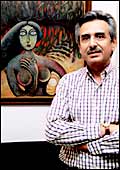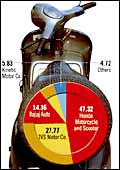 |
| Cruising along: Not only
is India home to the world's largest bikemaker, but also the
second largest two-wheeler market |
In
1983, when Japanese two-wheeler giant Honda wanted to enter the
Indian market, it made its first stop at Bajaj Auto. The reason
was a no-brainer: Bajaj Auto was the scooter king of India, accounting
for a 75 per cent share of the Indian two-wheeler market and an
enviably long queue of customers who were prepared to wait as
long as eight-nine months for allotment of the Bajaj Chetak, its
most popular model, which owed its heritage to the Italian Lambretta
of the 1950s. Honda, which wanted to launch its motorcycles first
in India, figured Bajaj Auto would be the best joint venture partner
it could have. But Bajaj Auto was then on a high and Rahul Bajaj,
founder and then managing director, was betting big on scooters
and not on mobikes, at least then. The Honda overtures were spurned
and the Japanese company forged a JV with the Ludhiana-based Hero
Cycles.
In hindsight, Bajaj made a bit of a mistake
then. He read the market wrong. It belonged to motorcycles, not
scooters. Today, Bajaj's son, Rajiv, admits as much. At a recent
dealer conference, he admitted that Bajaj Auto had missed the
seismic shift of consumers from scooters to motorcycles (he doesn't
regret the lost opportunity with Honda though!). Back in 1995,
the Indian two-wheeler market comprised 1.2 million scooters and
just 760,000 motorcycles. In 2004-05, it's the other way around:
0.92 million scooters and 4.96 million motorcycles.
 |
"Rural
buyers are extremely aspirational; they know the latest trends,
but are more conscious of price and fuel economy"
Sanjiv Bajaj
Director (Finance)/Bajaj Auto |
A 10-million Bike Market
It wasn't that the entry of motorcycle manufacturing
JVs like Hero Honda Motors or Yamaha's erstwhile JV with Escorts
or Suzuki's with TVS changed the market overnight.
It was gradual. The new four-stroke motorcycles
launched by Hero Honda, in particular, offered greater fuel economy
(which made them attractive to consumers at a time when fuel costs
were rising) and unmatched reliability. Hero Honda's memorable,
"Fill it; Shut it; Forget it" advertising slogan said
it all. Buyers took the bait. By 1998-99 things had changed very
dramatically. What had been a scooter market was now becoming
a motorcycle market. For the first time, motorcycle sales exceeded
those of scooters-1.36 million as against 1.29 million, which,
incidentally, is the all-time high for scooters.
Drama happened elsewhere too. By 2002-03,
Hero Honda had vaulted past Bajaj Auto to become India's largest
two-wheeler company. And this year, the company's annual sales
are expected to be close to three million units, larger than what
the entire motorcycle market was in 2001-02. The pace of growth
of motorcycle sales has been remarkable, clocking a compounded
annual growth rate of over 20 per cent over the decade between
1995-96 and 2004-05. And there's no sign of a let-up in that pace.
In the first seven months of last year, motorcycle sales grew
18.83 per cent. (Cars grew 6.9 per cent.)
The world's largest two-wheeler manufacturer
Honda is so excited about the prospect of India being a growth
market that it has started a second two-wheeler company in India,
Honda Motorcycle & Scooter India (HMSI). Its Managing Director
Yukihiro Aoshima believes that it is not a question of if India
will become a 10-million motorcycle a year market, but when? Quite
soon, perhaps. If the market for motorcycles continues to grow
at the current rate, that could happen in the next five or six
years. However, Pawan Munjal, Managing Director, Hero Honda, the
world's largest single manufacturer of motorcycles, believes it
could happen before that. "Just look at the rate the market
has been growing at, and there are no reasons for the growth to
slow down. I believe that we will cross the 10-million mark before
2010," he says.
 |
"A
motorcycle is still a very aspirational product in small towns
and cities. It is the ultimate symbol of an India on the move"
Satya Sheel
Managing Director/Suzuki Motor India
|
Revving Up In Rural India
No one's more bullish than the players in
the industry. Suzuki Motor Company might be better known in India
as being the largest carmaker Maruti's parent company, but across
Europe and America it is better known as a maker of motorcycles
and, after divorcing its Indian partner TVS almost four years
ago, it is on the verge of making a return to the Indian market.
"A motorcycle is still a very aspirational product; in smaller
towns and cities when people buy a motorcycle it gives them a
certain feeling of prestige. And most importantly it gives people
a sense of freedom, it opens up opportunities, which is why people
will continue to buy motorcycles. The motorcycle is the ultimate
symbol of an India on the move," says Satya Sheel, Managing
Director, Suzuki Motor India.
With swathes of rural India, where 70 per
cent of the population lives, yet to be targeted by marketers,
and the growth of roads in the countryside, two-wheeler sales
are expected to keep growing. Besides, with rising incomes and
youth dominating the demography-by 2011, a quarter of the population
will be in the 15-24 age group (according to the 2001 Census)-everything
seems to be in favour of two-wheeler manufacturers. "Rural
roads will be the biggest driver of two-wheeler growth,"
says Arindam Bhattacharya, Director, Boston Consulting Group.
"There are some 25 million motorcycles on Indian roads. So
you can work out how under-penetrated the market is. A lot of
the motorcycles on roads today have been sold in urban areas,
but the bulk of two-wheeler sales in the future will come from
rural areas. In fact, I find it surprising that no one has actually
tried to make another 'Rajdoot' (a popular rugged motorcycle in
the 1980s) in India."
Rural markets already account for almost
a third of all motorcycle sales but, according to Munjal, rural
users account for at least half of all motorcycle users, "Many
buyers go into big towns to buy motorcycles, so a company like
ours can't treat the rural consumer lightly." The problem
is one of reach. "We're not an FMCG company that can reach
every nook and cranny of the country. We're an engineering company.
No matter how reliable and efficient you make a product, it might
need to go to a workshop and you can't possibly establish workshops
everywhere," says Munjal. Still, Hero Honda is developing
an innovative way around that by starting mobile workshops.
Japan Rules
In scooters, the Japanese sun
has risen over the son of the soil. |
 |
Financing The Rural Buyer
Although motorcycle manufacturers and dealers
point out that the majority of sales (in rural markets) are cash
purchases, often as part of the dowry during weddings, finance
options for rural buyers of two-wheelers are growing. Overall,
while 95 per cent of car deals are financed, only around 60-65
per cent of motorcycle purchases are financed. However, unlike
cars, motorcycle sales have a few problems. "The ticket size
is quite small, which means that interest rates can be quite high-in
the 16-18 per cent range," explains Sachin Khandelwal, General
Manager (Auto Loans), ICICI Bank. The other problem is that even
banks like the State Bank of India, which has 6,600 rural and
semi-urban branches, don't have the reach or resources needed
to service rural motorcycle loans. "It doesn't make sense
to go someplace where only one or two people will buy the product
in a year," argues Khandelwal, "We do reach over a thousand
cities and small towns, but reaching the village level is not
happening right now."
That is why Khandelwal feels that the best
way for two-wheeler finance in rural areas might be via the self-help
group and micro-finance route. A route that Bajaj Auto is already
taking. "We have tied up with NABARD (National Bank for Agriculture
and Rural Development) to help more rural consumers buy our products
without breaking their back in the process," says Sanjiv
Bajaj, Director (Finance), Bajaj Auto. But Bajaj also feels that
rural buyers present a dichotomy to manufacturers. "Rural
buyers are extremely aspirational; they watch TV so they know
the latest trends in style and design, but they are far more conscious
of price and fuel economy," he points out. Bajaj Auto, which
struck gold with its entry-level model, the ct100 knows this aspect
well. But as Hero Honda's Munjal points out: "The entry-level
segment is growing, and with motorcycles today priced as low as
Rs 29,000, it will continue to grow. But with input costs rising,
margins are under a lot of pressure. Reductions can still be made
in the distribution and marketing structure, but I believe that
prices of motorcycles have gone as low as they can possibly go."
 |
"Just
look at the rate the market has been growing at. I believe
we will cross the 10-million mark before 2010"
Pawan Munjal
Managing Director
Hero Honda Motors |
According to players like Munjal and others,
the meat of the market will continue to remain what the industry
dubs the 'executive commuter' segment. Hero Honda, which dominates
this segment with its Splendor and Passion models, believes that
the biggest chunk of the market will remain in this segment for
the foreseeable future. "There is a gradual shift of consumers
towards higher-powered bikes, but most consumers will upgrade
towards a 125cc product, not 150cc and upwards," says Munjal.
Despite the entry of new players like HMSI
and Suzuki, which is expected to launch its bikes later in 2006,
and older players like TVS Motor, Yamaha and LML, the motorcycle
market is a game of two, Hero Honda and Bajaj Auto, who together
account for 80 per cent of the domestic market. Add TVS Motor
to that club and it controls 90 per cent of the market. "Do
I think Hero Honda can hold on to a 50 per cent market share?
Difficult, but not impossible," says Munjal. His arch rival
Bajaj Auto, still smarting after being dislodged from its numero
uno position, is not one to give up. At a recent summit, Rajiv
Bajaj highlighted his single-point agenda: to regain top spot.
Both companies are ramping up their capacities to take advantage
of the coming boom and, of course, to continue their cut-throat
battle. You can be sure, 2006 won't be a dull year for the two-wheeler
market.
|








